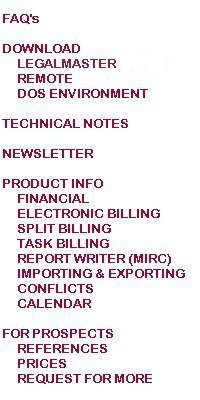

How do I
handle a fixed fee case?
The client has
paid up front, but I want the timekeepers to receive proportional
credit for their time.
The crux of
this problem is that since you don't know the value of the time
worked on this matter until it is complete, you can't bill for fees
until then. Nevertheless, you still want to keep track of the money
received. This solution addresses both of these concerns.
There are a
few ways to address your requirement, here's the one that we prefer.
-
Enter a
retainer billing for the amount of the flat fee. Merge the billing transaction.
- When you
get your money from the client, enter a payment against that retainer
billing. This has two effects; viz., it reduces the retainer A/R and
it creates a retainer balance equal to the amount of the payment.
- Put the
matter on hold. This allows you to accumulate all of its fee and cost
activity yet defer "billing" until you've entered all of
its transactions. If the flat fee includes costs, use status code I
(hold fees and costs). If the flat fee covers just fees, use status
code F (to hold fees only). Either of these status codes allows the
retainer receivable to continue to be billed as a balance forward if
the client didn't pay all of it yet.
- Enter your
fee activity at your most common billing rate. You won't actually be
charging your client at this rate, but this will allow you to
determine whether or not the case was profitable by using this rate
as a standard.
- At the
conclusion of the case, after all fees (and costs, if relevant) have
been entered, go to Transactions/Fees/List Alter, enter the client
and matter codes and click on Options/Automatic distribution of
write-ups and write-downs. In the "new billable" box, enter
the amount of the flat fee to be attributed to fees. Do not click the
"adjust hours" box. Then click "redistribute."
This process writes up or down (depending on whether or not the value
of time work exceeded the amount of the flat fee) each and every time
entry assigned to the matter. It does this by changing each
transaction's "billable" amount while leaving the
"actual" value of each individual entry unchanged. As a
result, you can determine, timekeeper by timekeeper, the
profitability of the matter.
- Take the
case off of hold.
- Run the
billing generator. This will create a fee receivable precisely equal
to the flat fee amount.
- Enter a
Retainer Transfer to pay the receivable. As a result, you will credit
your A/R and debit the balance in your retainer account.
- On
management reports be sure to include a column for retainer
transfers. They reflect the fee credit applied to each timekeeper
just as does a fee payment. (You may want to use Legalmaster's
"calculated field" capability in MIRC
to add fee payments and fee retainer transfers together and thereby
get a single figure representing fee credits.)


